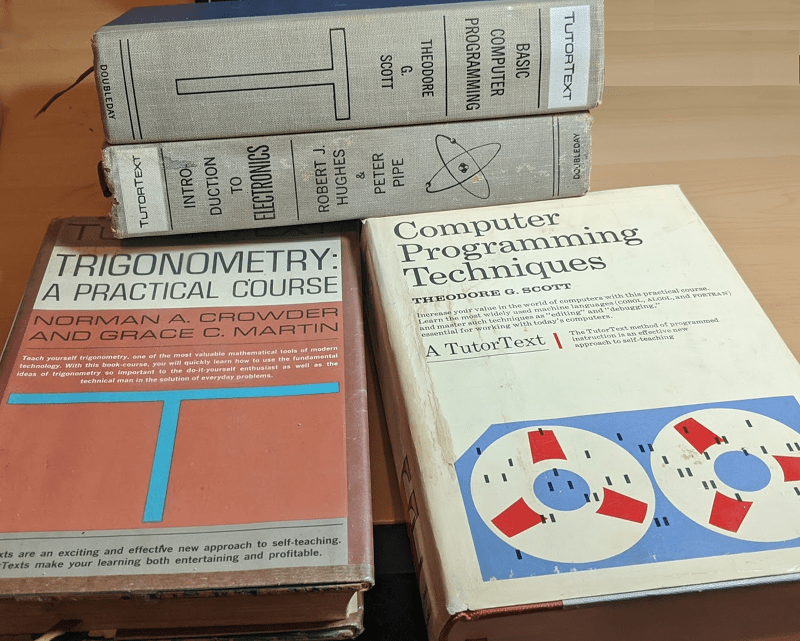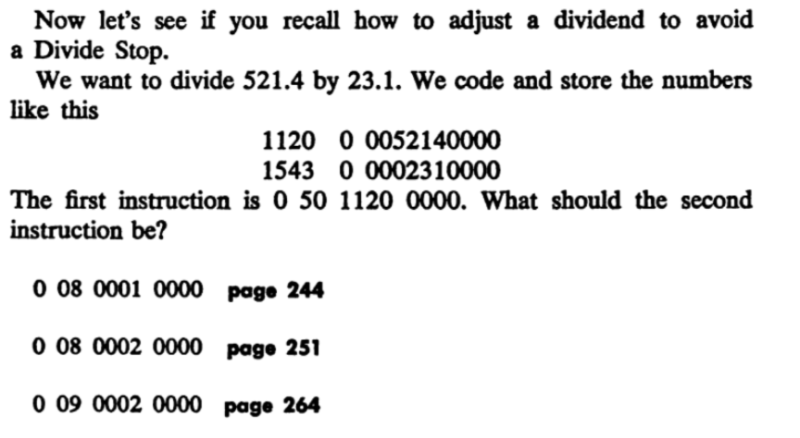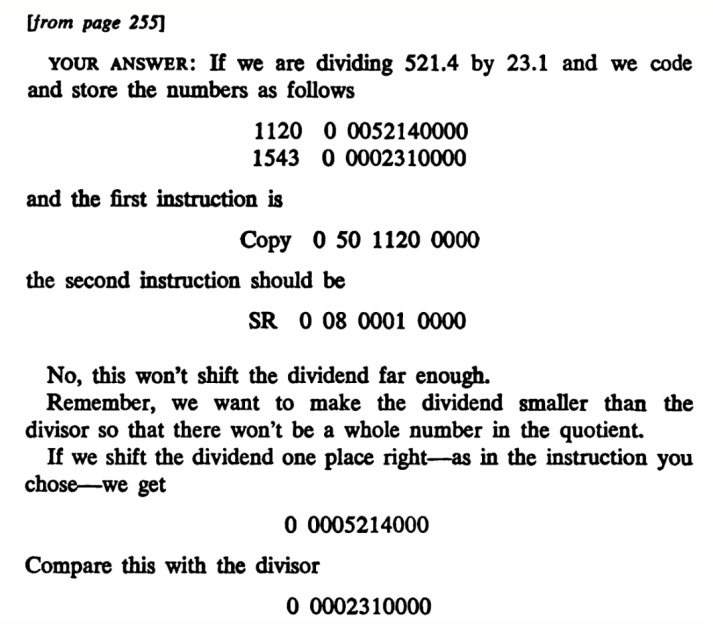Have you ever had one of those books that let you choose your own adventure? You know, the book will say “The bully tells you to hand over the secret message. If you want to run away, turn to page 48. If you want to fight him, turn to page 70.” While this is normally a staple of children’s literature, there were a series of training books known as Tutor Texts that used the format to teach technical topics.
In fact, one of these books was my first introduction to computer programming more years ago than I care to admit. But it wasn’t just computer programming. There were titles from the same publisher about trigonometry, slide rules, and even how to play bridge. I own four of these old books and it got me to thinking about how we deliver information on the web. Maybe these books were ahead of their time.
The Advantage
 Assuming a book like this is well constructed, this is a pretty good idea. A regular book just tells you something and then — maybe — asks you a question or two to see if you got the idea right. If you don’t, you have to go back and reread the same material that didn’t make sense to you in the first place.
Assuming a book like this is well constructed, this is a pretty good idea. A regular book just tells you something and then — maybe — asks you a question or two to see if you got the idea right. If you don’t, you have to go back and reread the same material that didn’t make sense to you in the first place.
If you think back to some skill you struggled with, you can probably see the value of getting a second or even third take on the same topic. For example, think about learning to tie your shoes or even a necktie. It probably seems effortless now, but whoever taught you probably had to show you several different ways. Ditto for riding a bike.
With the Tutor Text approach — technically known as programmed instruction — this isn’t how it works. You are given a problem and if you choose the wrong answer, you are directed to a new different explanation. Once in awhile the text will simply give you an explanation and tell you to go back and try again, but often the wrong answer pages take you on a detour path to correct your thinking before rejoining the main line of the book.
As a side note, there are other techniques that also fall under the umbrella of programmed instruction, training, or learning. For the purpose of this post, I mean programmed instruction to be in the style of the Tutor Texts: ask a multiple choice question and then explain why it was correct or incorrect before proceeding. As far as I can tell, the technique originated with the US Air Force where psychologist Norman Crowder used it to efficiently train maintenance crews in the 1960s.
For Example
For example, in the computer programming version of the book, they are using an imaginary machine called TUTAC that works with decimal numbers — not unheard of in the 1960s. (We’ve talked about the TUTAC and other made up machines of those days before.)
Here’s an example problem:
Honestly, I don’t remember the answer — I haven’t really read this book since I was 12 years old. But let’s just randomly pick the first answer and go to page 244:
Oops. From the context of this answer, I’m guessing the correct answer was on page 251. That page not only reports you are correct but explains why you are correct before posing a new question. Sometimes there is new information before the new question and sometimes it is just a multi-part question.
The Problem
Although the better topics lead you to more practice problems when you stumble, the more complex ones tend to give you an explanation and then send you back to the question to try again. Why? If you try writing something like this yourself, you find that it quickly spirals out of control. You explain A but the reader doesn’t get get it. So you explain it again, but still no dice. So you review something from the past and ask again. Nothing. Now what? There has to be some limit to how much you branch.
Sometimes it is hard to know in advance the topics people aren’t going to understand. If you’ve ever tried to teach someone to tie a tie or ride a bike, you know what I mean. It is so easy once you know how. But until you get to that point it is nearly impossible and — worse — once you do know, you forget why it was so hard in the beginning. Ideally, you want to design questions that have answers that indicate where there is a misunderstanding.
 For example, if I showed a picture of two resistors in parallel connected to a 10 V battery, I might ask: What’s the voltage across the two resistors? The correct answer, of course, is 10 V. But I might throw in 5 V as a decoy answer because some people might think the resistors split the voltage, for example. Another answer might be 10 divided by the sum of the resistors in case someone thought it was an Ohm’s law problem.
For example, if I showed a picture of two resistors in parallel connected to a 10 V battery, I might ask: What’s the voltage across the two resistors? The correct answer, of course, is 10 V. But I might throw in 5 V as a decoy answer because some people might think the resistors split the voltage, for example. Another answer might be 10 divided by the sum of the resistors in case someone thought it was an Ohm’s law problem.
There’s also the problem of combinatorial explosion. Let’s say you have a topic about interpreting a data dump and from the answer the reader chooses, you realize they don’t know hexadecimal. No problem, you just write a topic on that. But now you realize they don’t understand exponents. Chains like this can go on and on.
Modern Day
You do see programmed instruction from time to time in your Web browser, but you’d think it would be ubiquitous, and it isn’t. A lot of training courses are little more than overhead slides converted to PowerPoint. Yet this seems like a missed opportunity.
Think about it. With a computer-based text, you would have a lot more options. The excellent EDx electrical engineering class, for example, can give you random practice questions. I assume the author could give a range of values and relationships (e.g., R1=5K to 10K, R2=(1.8 to 2.2)*R1). The computer solves the problem and knows the answer. So if you work the same practice problem four or five times, you get a different answer each time.
Imagine a report that showed which incorrect answers have the most hits and, perhaps, which have none. Which topics have a high percentage of incorrect responses the first time through? Maybe that text needs some additional thought. How long do students read a topic before answering? Lots of data to mine that could make the material better.
 It is interesting that if you search Google for “programmed instruction” most of what you get back are pedagogical articles about the technique. There are a few other books that have used the technique. However, more used a different form proposed by B. F. Skinner where questions and answers appear after a short bit of text. “Bobby Fischer Teaches Chess” is a good example, as is Quick Calculus.
It is interesting that if you search Google for “programmed instruction” most of what you get back are pedagogical articles about the technique. There are a few other books that have used the technique. However, more used a different form proposed by B. F. Skinner where questions and answers appear after a short bit of text. “Bobby Fischer Teaches Chess” is a good example, as is Quick Calculus.
Radio Shack had a ham radio course called “From 5 Watts to 1,000 Watts” that proudly proclaimed it was a programmed course. While a lot of online courses do insert activities as these books do, there are few that do the multiple-choice/explanation style that the Tutor Text uses.
Future
Maybe one day this kind of programmed instruction will be popular again. It wouldn’t be hard to build a web-based framework to present this kind of thing. You could even do it with PowerPoint, in a crude way. After all, in the 1960s they did it with paper.
Meanwhile, the Tutor Text stands as a great tribute to the concept. They taught me a lot, and I’m sure a lot of others, too. Of course, nowadays you can also take college courses online, many for free. Or go old school and learn electronics from the Navy.


















So of course once I finished reading this I DDG’d TutorText and happily there was one up on the Internet Archive.
https://archive.org/details/TutorText_on_Nutritional_Cooking/page/n11/mode/2up
Fascinating use of learning in the pre intertubes era.
Off topic: hadn’t seen that “DDG’d” usage before. Not quite as catchy, rolly-off-the-tonguey a verb as “googled”. But, neither “ducked” nor “goosed” seem quite right somehow. Though, “goosed” seems more likely to catch on, as in: “How did you find that information?” “I just goosed the internet.”
If you search archive.org for “TutorText”, at first this seems to be the only one they have. But if you put that into “Search text contents” instead of “metadata”, you get a lot more: trigonometry, algebra, and computers.
@JRD said: “If you search archive.org for “TutorText”, at first this seems to be the only one they have. But if you put that into “Search text contents” instead of “metadata”, you get a lot more: trigonometry, algebra, and computers.”
Yes, but you only get the “Search text contents” option AFTER you do a standard (less productive) search. And don’t bother clicking straight through to the “Advanced” search page where it seems (to me anyways) that there is no “search text contents” option at all!
Almost as long ago, IBM used to have parts their service documentation/troubleshooting books (maps?) in a very similar format. Great if you’re a 3rd shift grunt with a 6262 printer that’s being cranky and an 0700 delivery deadline.
“fault trees”…list of symptoms, pointing to other lists of symptoms, and on down until you get to a probable diagnosis
“once you do know, you forget why it was so hard in the beginning”
Once aspect of Benner’s From Novice to Expert is why expert nurses should not be the clinical trainers for new grad nurses. Scenario – Expert: “Hmmm, I don’t like the way he looks.” Novice: “Why?” Expert: “Well, he just doesn’t look good… I’m calling the intensivist.”
One aspect of having internalized many of the aspects of assessing a patient is that they _are_ internalized, and not easily accessed to explain with a logical progression of the factors leading to the “doesn’t look good” statement. For the novice the experience can be one of frustration due to the near magical conclusion with apparently little supporting logic.
On the other hand, my experience with ICU physicians was that they respected and acted on such assessments without necessarily asking for an in-depth explanation of how the conclusion was reached. An aspect of the “Art” vs “Science” in Medicine. There really is an underlying scientific basis, but externally it looks to be just opinion…
Brings to mind Gladwell’s “Blink”.
Interesting observation.
Hey Al! About that necktie;-)
https://hackaday.com/wp-content/uploads/2015/07/al-williams-headshot.png
I suppose if I grow my beard out longer I could braid it.
Ok, “Once” should have been “One.” Fingers faster than brain…
The trig book was the one I learned trigonometry from. Wonderful self-paced learning is what I remember (in addition to the trig).
I am a big proponent of programmed instruction courses. I still have a few that I will never give up. One of the first is a book by B. F. Skinner and Norman Crowder on “operant conditioning” which is not only written as a programmed instruction course, but explains the theory behind it.
I first got a glimpse of programmed instruction in an article in Reader’s Digest (1961?) by Wolfgang Langewische. Then, when I was in the Army, I learned to program IBM 1401 computers from a two-volume programmed instruction course by IBM. I was HOOKED! (AUTOCODER- – an assembly language) I subsequently learned about flying from the Jeppesen course (which may still be in use); I learned Biblical Greek and Hebrew from a programmed course offered through Loyola University; Learned Electronics from a course printed by Federal Electric; and many other subjects.
I used to hunt down subjects to learn through programmed instruction. A lot of them were actually on computer administration and programming (from Honeywell, Burroughs, Univac, Control Data, and IBM, particularly.) I earned money by tutoring Juniors, Seniors and Graduate Students in Math and Physics, and my secret weapon was programmed instruction courses.
From where I am sitting, I can see a few of my favorite programmed instruction courses: A TutorText book on the Slide Rule, Another TutorText book on Business Writing, Blumenthal’s books on English (English 2200, 2600, 3200), and my all -time favorites; “Engineering Mathematics” and “Advanced Engineering Mathematics” by Ken Stroud (Both 5th Edition). Those Stroud books are worth their weight in GOLD! Over the years I have taught people who never thought they could learn Mathematics well enough to pass their exams. I used the Stroud books and they not only learned the Mathe they needed, but they learned it in less time than they would have if they had taken courses. (Do NOT loan these books out! They are a little harder to come by these days, and they WILL get stolen.) I have multiple copies of “Bobby Fischer Teaches Chess” and I have an even better Chess course published by Encyclopaedia Britannica.
The TutorText books are what are called “branching”-style programmed instruction courses. This means that the response you make will lead you to a specific answer if you get it right, or send you to a page that branches you back to the originating page if you are wrong. The advantage is that the more times you are right, the less reading you have to do to finish the course.
The Blumenthal and Stroud books are what they call “linear”-style. They simply lead you one small step at a time through the entire contents of the book. Statistically, there is supposed to be no difference in results between the two styles. (Skinner preferred the linear style, and Crowder preferred the branching style.)
The programmed frames were supposed to be tested so that there was no less than a 98% chance of answering correctly. Programmed instruction books are about three times the size of a regular textbook (but can be completed in about one-sixth the time), and harder to edit, and this made them unpopular with book publishers.
The principles of programmed instruction were used by teaching machines from Texas Instruments, and Control Data Plato systems.
If you want to learn how to make your own programmed instruction courses, all you need is a thin little book called, “Practical Programming” by Peter Pipe (if you can find it). I suggest you use decision tables to keep your frames and responses in order.
There were some things published in the ’60s and ’70s that called themselves “programmed instruction”, but all they did was divide regular prose into a couple of small paragraphs and ask a question afterwards. There was no testing and no real programming to the presentations. The book, “Quick Calculus” mentioned in the article was part of a series by Wiley called “Self Teaching Guide” (STG) which are still around. These fall somewhere between the quality of a tested, statistically-provable program and the chopped-prose type I just mentioned. I have dozens of these around. Some are much better than others.
When Skinner became unpopular, publishers “threw out the baby with the bathwater” so to speak. One of the lousiest things to come out of the PC revolution was CBT courses that were nothing except video lectures. There could be a terrific match between online learning and programmed instruction principles, if anybody really cared. (Disclaimer: I have created some for private companies internal training. I’m a believer!)
“If you want to learn how to make your own programmed instruction courses, all you need is a thin little book called, “Practical Programming” by Peter Pipe (if you can find it). I suggest you use decision tables to keep your frames and responses in order.”
Sounds a bit like what Articy:Draft makes possible.
https://store.steampowered.com/app/230780/articydraft/
Similar goal in managing branching decisions.
The main problem with this TutorText approach is that it’s trying to teach you, rather than just present information. That obviously isn’t the right thing to do.. (sarcasm)
There’s different ways of presenting the information due to the different ways we accept information.
https://www.rasmussen.edu/degrees/education/blog/types-of-learning-styles/
Testing is the easier part.
I’ve never bought this rational. I have a hard time believing that everyone’s best method isn’t to learn by doing. However, some people have a hard time learning simply reading or listening to a lecture. I admit, I’ve never read the research on how this conclusion was reached. Or maybe I did and that’s just not my best method of learning.
Oh, I have no problem believing that it’s at least a FACTOR. Anyone on this site is, OF COURSE, a “learn-by-doing” type. That’s self-selecting for a community like this.
But there are a lot of people out there who are too far timid, in the face of unfamiliar concepts or activities, for learn-by-doing to be an effective teaching method. They’ll never manage to do any actual doing, being so paralyzed by their own lack of comfort with the subject and so hung up on the possibility of failure (whether that’s due to personal insecurities or because someone in their life messed them up but good) that the only thing they’ll gain from a try-fail-reevaluate-try_again loop is the “fail” part — and that’ll negatively reinforce their next attempt, so the problem becomes self-perpetuating.
Most of us had to overcome that fear of failure, in becoming comfortable with trying new things specifically because we want to fail and learn from it. (A few of us were born without those hangups, probably, but for most it was at least something of an evolutionary process.) We forget that not everyone gets there, though.
You might argue that the fear of failure is a learned issue, and that everyone can be taught to embrace learn-by-doing. But I’m not so confident that’s a universal truth, just because I know that it happens to work for me personally.
This page has a list of all the titles TutorText printed:
https://gamebooks.org/Series/457/Show
In case you wanted to search BookFinder for hard copies.
Thanks for a very interesting article and thanks to the many users that posted helpful comments and links.
I had my first formal introduction to computers and programming by means of a programmed instruction course 40 years ago (nice big book; computers at home or the Internet were “science fiction” those days…).
I really enjoyed it and found it useful and easy. I think that modern online versions will be of great help to young students today.
Just one personal thought about the method: for it to be really useful, you have to be sincere and “do the right thing”, you must “feel” that you really know the answer to the book’s question or exercise before proceeding to the next one. If you make “a lucky guess” you may choose the right answer but you will not be really learning and will only be deceiving yourself.
Best regards,
A/P Daniel F. Larrosa
Montevideo – Uruguay
Seems part of testing is “do they understand the core concept”? All the ways of probing around the student to see if they really do understand and not some other effect like memorization.
“For the purpose of this post, I mean programmed instruction to be in the style of the Tutor Texts: ask a multiple choice question and then explain why it was correct or incorrect before proceeding. As far as I can tell, the technique originated with the US Air Force where psychologist Norman Crowder used it to efficiently train maintenance crews in the 1960s.”
The Navy also did this stuff, as per your definition, but with a bit of computer automation, which was somewhat hi-tech for the era. Went to several schools at NATC Millington during mid/late 1970s. The introductory/review stuff prior to ‘A’ school was (self-taught) programmed instruction, where you sat in a carrel for a week or two to get up only when you submitted the scantron form to the computer to be told what to study next. And parts of the avionics ‘A’ school was also programmed instruction, but there were still many instructors available.
Some years after my A and various C schools, was sent back for ‘B’ school which is the more complex stuff and was all instructor taught. Unless you are a genius, there are limits to the subject matter that can be self-taught, programmed instruction or otherwise.
I did like the programmed instruction style of self-teaching, because once you got ahead of the computer’s allotted time for each segment, you could take the rest of the day off. But this caused no end of trouble – think about it, a bunch of (somewhat) smart 18 and 19 year old sailors and marines that only had to ‘work’ 5 or 6 hours per day. What could possibly go wrong? The law of unintended consequences.
Gosh, this seems like a nightmare.
Tell me what to do, tell me how to do it, test me on it.
Scoop o’vanilla, scoop o’chocolate, don’t waste my time.
In modern times, if it’s something someone already knows how to do, it’s usually either already automated, or something that can’t be directly taught.
They probably hope to give you more of an understanding than just getting the right answer, since basically nobody in school now is going to need to add or subtract on paper, or find the exact predrill size for a screw without looking at their phone, or interpret error codes that will have changed next week anyway.
As I understand the point of learning technical things is to be able to find new solutions to things, which requires knowing exactly what all the parts do and how they got together.
I know very little math, and have never been held back by not knowing the times tables, but id imagine the job market would be a lot different knowing linear algebra or something.
This isn’t just “testing” you to see if you got the right answer. The theory behind this is that we learn more from successful actions than we do from unsuccessful or confused actions. By generating a a chain of continuous successful responses, the student actually “reinforces” the learning and advances in learning the subject. This is “behaviorism” and “operant conditioning” at its best. The same process is used for training dogs and other animals, but beause the human mind is so flexible, it takes very little to set up a conditioned response in this learning environment.
That’s a big part of it, yeah. The /wrong/ answers someone chooses can often be more enlightening/revealing than the _right_ ones — it’s never completely clear, in those cases, whether it means they really understood the problem completely, whether they just guessed randomly and got lucky, or whether (worst of all) they picked the right answer, but for totally the wrong REASON.
If the wrong solution leads to the right answer, that’s only going to reinforce that errant thinking in ways that’ll usually bite them later. Whereas, if that same errant thinking takes them to a particular wrong answer, it’s often fairly clear how they went astray. (A well-designed test would of course have multiple questions designed to expose those issues — you’d want a test where a certain misunderstanding or shortcut might sometimes lead to the right answer for one or two questions, but then be the exact reason for getting others wrong. Then, you can be pretty confident that even the right answers were products of the same mistake, which will need to be un-learned.
Instructors actually do think about these things. The OP sketched out this scenario:
“Imagine a report that showed which incorrect answers have the most hits and, perhaps, which have none. Which topics have a high percentage of incorrect responses the first time through? Maybe that text needs some additional thought. How long do students read a topic before answering? Lots of data to mine that could make the material better.”
I’m only surprised that the author imagines data like that ISN’T being collected and analyzed. I can assure you, there are educators who study test RESULTS at least as hard as their students study for the test itself, and use those results to adjust both the tests themselves and how they teach the material they’re testing on.
Heck, I had a high school science teacher — and this was so long ago the years started with “19” — who didn’t just grade our tests, he ran a full data-analysis series on the results. There were charts and graphs. No PowerPoint, but in his defense that’s only because the first version was still two years away from being released.
He also used that pile of data for the mutual benefit of everyone involved. Tests in his class were graded on a simple, fair curve: Any question more than 50% of the class answered wrong wasn’t counted towards the final grading. The relatively-few students who answered correctly would still get credit (which means it was usually possible to get a grade over 100% on his tests), but there was no penalty for missing it.
The way he explained it was, “If at least half of you couldn’t come up with the right answer, that’s my fault, not yours. Either I didn’t teach that topic correctly, or there was something wrong with the question itself. Regardless, you shouldn’t be penalized for my mistake.”
This sounds a lot like a book I recently bought called Quick Calculus: A Self-Teaching Guide. It’s actually worked really well for me and been quite interesting, allowing me to patch up holes in my knowledge while not getting bogged down in the things I understand.
This is what I always wanted and expected from the learning software I bought as a teenager. I think TLC made software for programming, electronics, and math. The software was awful. Hoping for a technological advancement, programmed instruction is also what I expected from online college courses as an adult. To say that neither fulfilled my expectations is an understatement. Perhaps my expectations were set by some early exposure to one of these books. I’m unsure why we have not caught up to the 60’s self-teaching books in software based learning. I think we, as Hackaday readers, have taught ourselves to learn the hard way. The hard way trains our intuitions in the same manner that programmed instruction trains our intuitions. Being instructed on the correct method does not train intuition. How can we generalize this process in a manner to teach ourselves and others better? Has this already been done? I think teaching math should be the best exercise. Teaching math is not magic or art. Wrong answers are wrong for specific and precise missteps. Clearly, this shouldn’t even involve AI if a book does a better job of providing feedback than most professors I’ve had. Who is up to the task?
Someone converted a TutorText to a webpage: https://www.arithmeticofcomputers.co.uk/